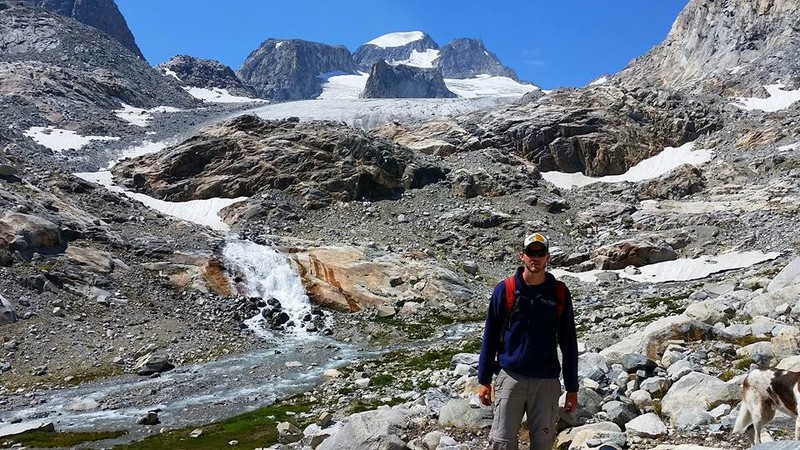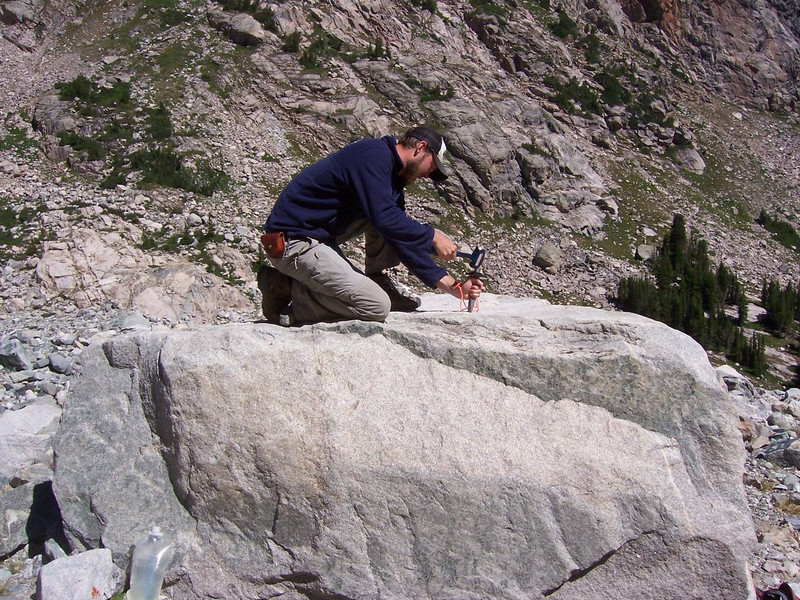CSC graduate student presents research on Wyoming glaciers

CHADRON – Chadron State College graduate student Adam Neumann of Fort Calhoun, Nebraska, spent the summer of 2016 in a remote Wyoming setting, researching glacial geology, an indicator of climate change.
In April 2017, he presented his research findings, which are the core of his thesis on glacial geology, at the Nebraska Academy of Sciences in Lincoln.
Neumann, who is pursuing his master’s degree in science education from CSC, camped in the Wind River Range for 15 days collecting cosmogenic radionuclide samples to determine at what rate deglaciation has been occurring in the upper Dinwoody Canyon during approximately the past 11,500 years.
The area has the second highest density of glaciers in the 48 contiguous states, according to Neumann.
Geological or paleo climate data will be inferred from the location and timing of terminal moraines or rock debris at the foot of Dinwoody and Gannett Glaciers, about 12,000 feet above sea level.
CSC geoscience professor Dr. Mike Leite is impressed with Neumann’s interest in climate change.
“Adam is doing important research. There are huge questions that need to be answered. He enjoys the outdoors and he discovered there is a demand for this kind of research. Glaciers are an endangered resource. They are melting away and we need data to understand climate change,” Leite said.
Neumann encountered a number of obstacles during his project, but methodically worked through them, Leite said.
One of those obstacles was acquiring a wilderness research permit from the officials with the Shoshone National Forest to collect about 80 pounds of granite and gneiss from the Fitzpatrick Wilderness, home to 44 glaciers. Because power tools are not allowed in wilderness areas, samples had to be collected with highly specialized carbide masonry chisels and sledge hammers.
Funding was another puzzle Neumann pieced together with the support of Leite and Dr. Joel Hyer, dean of the School of Business Entrepreneurship Applied and Mathematical Sciences and Sciences. Neumann applied was awarded grants from the CSC Faculty Senate Research Institute Committee, NASA Nebraska, the University of Vermont (UVM) and the Purdue Rare Isotope Measurement Lab.
Through his work with UVM, Neumann has become acquainted with two of the nation’s leading glacial research experts, Lee Corbett and Paul Bierman.
To begin the study, Neumann completed a six-day preliminary trip to the site and a 50-mile round-trip hike on rough and unstable terrain with Leite in July. Leite emphasized this kind of advanced field research is reserved for graduate students like Neumann with specialized skills and experience.
Three days later, Neumann returned with two friends from a previous outfitting job. Their trip for actual material collection took another 10 days.
Neumann and another CSC graduate assistant, Nate Pindell, crushed and pulverized the rock samples at South Dakota School of Mines and Technology’s mineral preparation lab before sending them to University of Vermont where the quartz will be magnetically separated from the rest of the sample and chemically etched in acid.
The samples were sent to the Purdue PRIME Lab where they were analyzed with an accelerator mass spectrometer to determine how long the rocks around the glacier had been exposed to sunlight. From this data, the researchers will be able to make inferences about climate change in the Wind River Range.
According to Leite, Neumann’s people skills, experience with scouting and after school programs provide him with the background to pursue a career in education once he earns his master’s. Neumann said he is also considering an eventual Ph.D. in the relatively new field of glacial geology.
“I’m happy to have him working here at CSC. He’s very personable and has been able to make valuable connections and get the right people involved. He’s a high quality graduate student and was perfectly situated for this challenge,” Leite said.
Category: Campus News, Physical and Life Sciences, Student Awards & Achievements

